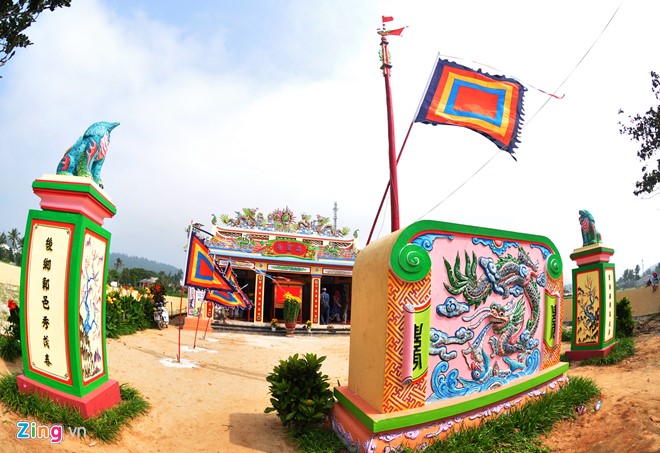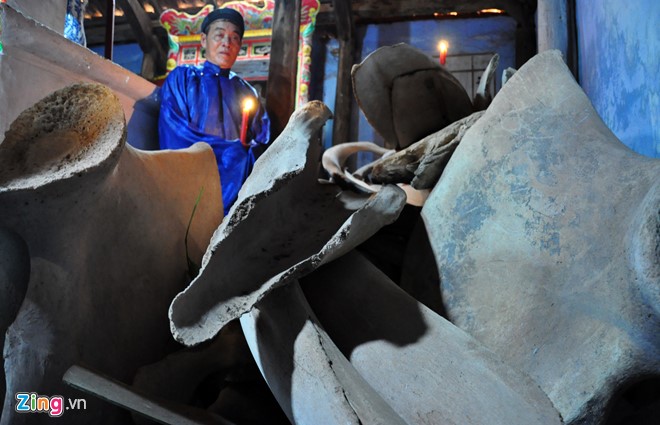Ly Son Island plans to restore Vietnam’s biggest whale skeleton
(VNF) - The central island district of Ly Son plans to restore a whale skeleton and an exhibition centre for whale skeletons with an investment of VND 10 billion (USD 442,477).
Vice Chairwoman of the district’s People’s Committee, Pham Thi Huong, said the restoration project will be built at Lang Tan Temple (Temple of the Whale) in the commune of An Vinh on Ly Son Island.
According to elderly residents of the commune, the 24m-long skeleton - believed the longest such skeleton found in Vietnam - was buried in the fishing village of An Hai nearly 300 years ago.
Islanders said the whale was found dead on the beach, but was too heavy to carry to burial inland and fishermen dug a big hole to bury it on the beach. They surmised that the whale had died off Hoang Sa (Paracel) Island of Vietnam and drifted ashore on Ly Son Island.
 |
The tomb named Lang Tan in An Vinh Commune has been recognized a national cultural and historical relic site by the Ministry of Culture, Sports and Tourism. This is the home for many of the largest old whale skeletons in Vietnam. (Photo: zing.vn)
Subsequently, local fishermen excavated the skeleton and placed it in a temple, where it was an object of worship. The Lang Tan Temple has been recognised as a national historical site.
However, some parts of the skeleton were damaged over the years and not repaired due to lack of restoration technology.
The district’s Vice Chairwoman said another whale skeleton was also found in the area, and the province will approve a supplementary fund of VND 4.1 billion (USD 181,415) for its restoration.
Whale temples, known as Lang Ong, are often seen in fishing villages, reflecting an old fishermen’s belief in the whale’s power to guard their lives at sea.
 |
Lang Tan is currently preserving three giant whale skeletons. (Photo: zing.vn)
Fishermen also express respect for the giant ocean mammals when they find it dead, and perform a respectful mourning ceremony. They build a bamboo basket to carry it to a final resting place in a temple. They believe this dignified burial and worship confer luck on all the fishermen’s descendants, who still make their living from the sea.
| |
Every spring, local fishermen organize rituals to worship the whales. (Photo: lehang12a1)
Ly Son district lies 18 nautical miles off the Vietnamese coast and covers an area of 10 square kilometres. It includes three communes An Hai, An Vinh and An Binh.
The island district has a population of approximately 2,100. The majority of residents earn a living from fishing and farming garlic and spring onion.
It was formed by five mountains, of which four are dormant volcanoes.
Centuries-old houses have been preserved, as has Am Linh Pagoda, built to worship the souls of sailors who died on long voyages.
A local museum displays over 200 ancient documents and 100 exhibits that prove that Hoang Sa and Truong Sa (Spratly) Islands belong to Vietnam.
In 2013, the Ministry of Culture, Sports and Tourism recognised the islands’ Hoang Sa fest as an intangible cultural heritage.
| |
A view from Hang (Cave) Pagoda, Thoi Loi Mountain, the tallest among the five mountains on Ly Son Island. (Photo: thachanhquan)
Observed for hundreds of years by families on the islands, the festival pays tribute to local men who enlisted in the Hoang Sa Flotilla to patrol the Hoang Sa and Truong Sa archipelagos in order to mine resources and defend the nation’s sovereignty over the area.
In previous centuries, the An Vinh communal house served as a recruitment centre for soldiers to protect the Hoang Sa and Truong Sa archipelagos from the Nguyen Dynasty in the 17th century.
Ly Son is striving to become a maritime economic centre by 2025, with a focus on tourism and aquaculture.
Archaeologists found relics of Sa Huynh culture on the island, which date back to 3,000 years ago. Starting in the 16th century, a number of ethnic groups migrated to Ly Son from the mainland and have inhabited the island ever since./.
| |
A view of the sea from Ly Son Island. (Photo: vohapv)
( Compiled by VNF )
Recommended
 Travel
Travel
Vietnam Through Australian Eyes: Land of Flavor, Warmth, and Timeless Charm
 Travel
Travel
Strategies for Sustainable Growth of Vietnam’s Tourism from International Markets
 Travel
Travel
Vietnam Strengthens Its Presence On The Global Tourism Map
 Multimedia
Multimedia
Phong Nha-Ke Bang National Park Named Top Adventure Travel Site
Popular article
 Travel
Travel
Vietnam Welcomes Record-High Number of International Visitors
 Travel
Travel
Luxury Train From Hanoi To Hai Phong To Be Launched In May
 Travel
Travel
Phong Nha Named Top Budget-Friendly Travel Destination for Spring 2025: Agoda
 Travel
Travel



